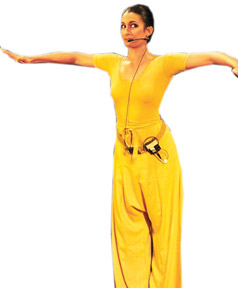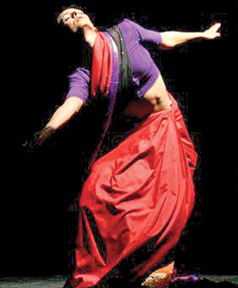MOM AND POP FUSION
Asuka Randeniye
 |
|
Bharatanatyam movement in ĎHybridí
India, 2012 |
She was born in Bayonne, in the South West of France. Her parents are
from two different cultures: mother French and father of Sri Lankan
Tamil origin. In an interview with Daily News Cťline Pradeu-Kanagasabai
talks of her ĎHybridí in Sri Lanka and many more......
Q: How did you start dancing?
A: I started dancing in France with Western Classical ballet
and after that I went to National Superior Conservatory of Paris to
study Contemporary Dance and after getting my dance diploma I studied
Bharatanatyam with a master in France for three years.
Q: Your show in Sri Lanka is called ĎHybridí. Why?
A: I chose this title because I wanted to find a hybrid
choreographic language between my fatherís side and motherís side; the
ĎFather languageí and the ĎMother languageí of Bharatanatyam and
Contemporary dance. This is what I call ďBharatemporary.Ē
Q: Was the choreography difficult to do? Did it take a long
time?
A: Yes... it did take a long time. I feel Iím still in the
process. I canít tell you itís done. Itís over. In the showó which is a
conference, a dance conference with the audienceó I explain how Iím
searching for this hybrid language. I speak about the basics of each
style so everybody in the audience know the basics and then I take one
basic technique from Contemporary and one from Bharatanatyam, mix it and
try to show how itís expressed through the body. Then the audience can
see the process.
Q: What can we expect from ĎHybridí?
A: The Hybrid project is tripartite. I explain to the audience
in the Conference how I create a choreographic piece. So I explain who I
am, what I do as a dancer and as a choreographer. I also speak about my
next performance, the Hybrid Solo. The Solo has no speechó itís one hour
of dancing. After that I have created an Exhibition of drawings related
to dance. Hybrid is all about the process. The Conference is about the
process of creation, the dances, the choreographic language etc. The
Solo is about the process of transformation and the Exhibition is about
the process of interpretation.
I watched one of your performances online, ďA Dancer and a ViolinistĒ
which was mesmerizing. Why did you choose to perform something new in
Sri Lanka rather than something Ďtried and testedí?
Well, ďHybridĒ was created in 2012 and itís a continuation of the
tour in India. The dance is pedagogic and thereís time for both speech
and dance. So itís quite lively.
The duet with the violinist was one of my earliest pieces. Now, itís
a bit difficult to imagine touring it in India or Sri Lanka because Iím
in underwear for some of the performance (laughs). In Europe I can be
naked on stage and no one will say anything, but in Asia, I canít do
that.
But the content of the Duet is like the ĎHybridí. Itís about
identity: how to match both the Occidental and Oriental roots in me.
Thatís my search at the moment.
 |
|
In ĎA
Dancer and a Violinistí 2009 |
Q: You are into ĎBharatemporaryí too. Bharatanatyam has a
spiritual foundation; Contemporary is very performative. Have you ever
had problems in fusing the styles together?
A: Not really, because I have learnt Bharatanatyam but donít
practise as a performer because I came to it for myself, for my inner
search, so itís more intimate than spiritual. I have all the vocabulary,
the mudras, the adavus to speak that language with my body but I donít
have a repertoire.
Contemporary seems demonstrative but you will see in the conferenceó
it is more about expressing freedom. Whether you like it or not really
depends on what you, as an audience, feel at the moment; if you donít
like the subject maybe you will like the quality of the body movement.
Itís not all yes or no; itís more subtle than that, so itís more
interesting. In classical dance itís difficult because if youíre not a
good technician, very quickly the audience will say, ďOh, she canít do
this.Ē
In Contemporary you donít have to understand everything, you only
have to feel. Thatís the real difference with the Classical styles, I
feel. But itís quite hard for the audiences to lose themselves and
forget the rules in the mind.
Q: Have you ever worried that when you are performing in India
or Sri Lanka, the contemporary aspects of the performance might not
resonate with the audience, because itís not very familiar?
A: Yes, of course, but thatís the challenge. There arenít many
people who can propose this kind of dance in this context and thatís
good for me because itís all a discovery. When you discover a new dish,
you donít know yet if you like it or not, and this is the same. Most of
the time the audience is very curious and they are surprised by what I
can introduce because itís quite pedagogic and when itís over they say,
ďOh, I didnít know thatĒ or ďNow I can appreciate contemporary danceĒ
etc.
I remember when I was performing in India, there were some
traditionalists in the audience. There is a part in the Conference when
they can speak, and one of them said, You used a traditional song played
by a band for a Contemporary moment! Itís a sacred song! But another one
said, No, no, itís a personal search, itís not your song, she can use
it. So itís interesting to see the different reactions.
Q: Youíve said before that you performing Bharatemporary is a
personal quest to connect with the two cultures you represent. Do you
think you have succeeded in this quest?
A: To a certain extent, yes. I am on the right way. I am still
searching because I was obliged to choose certain aspects for my
performances and fix them in position, like the order of the dance. But
the content is not fixed, so I can improvise. I want to continue
searching this language, even in the next creation but this project, the
Hybrid Project, gave me the opportunity to start the process of
searching.
Q: Was it a struggle for you to connect with both cultures,
before you started the Hybrid Project?
A: I came to an ďidentity crisisĒ in my first creation, the
Duet with the violinist in 2009. It started when I was twenty, when I
chose to learn Bharatanatyam and I realized my body was ideal for it; I
have flat feet which I can clap on the floor for Bharatanatyam but not
so good for going en pointe in Classical Ballet. But the search for an
identity in my life started earlier and afterwards, I had to search in
my artistic life as well.
Q: And dance has helped?
A: Yes, yes... Or not. Because I have to always negotiate
between the artistic and the personal, will the artistic choices fit the
personal? and vice versa. I started to create this choreographic piece
because of the personal and because of the subject (identity), I have to
know where I am, inside me, to decide on the choreography. Am I going to
be traditional for the Indian dance? Do I need a Hindu god or goddess
statue on stage? Do I perform naked? Itís always a choice.
 |
|
Cťline Pradeu. Picture by Saman Sri
Wedage |
Q: Do you think that the kind of style you perform in, a
fusion of two different cultures, can help people understand each other
better?
A: Yes, I think so. First of all I would say itís easier if
you are of mixed heritage; mixed cultures. Mixed heritage doesnít
necessarily mean from two countries; it can be from this village and
that village. The problem is, firstly, where is your middle? Where are
you? Are you, you? Or are you part of two? And after that, if they want,
they can project themselves to one side but you have to find a middle
ground. Me, in my Conference, I speak more about an inner search but it
can be a dual search, why not?
Q: Do you use other dance styles in your performances, apart
from Classical Ballet, Contemporary and Bharatanatyam?
A: In my own projects, no but I can perform a bit in Flamenco
style and Persian style. It wasnít very difficult to learn and it was a
lot of fun.
Q: What are your interests apart from Dancing?
A: I like music, theatre, really any artistic discipline. I
love my family, I have a child and Iím expecting a second one now
(laughing) so Iím very happy.
I love to travel so touring is very nice. Even if I donít have so
much time to visit places, because Iím working, itís interesting to meet
the people involved in the technical fields. Itís always different so
thatís really nice.
Q: Would you want to teach someday, pass on what you do?
A: I used to, I have the diploma to teach in France and I
taught in schools and I do workshops along with the performancesó I like
that. I like the exchange, so yes.
Q: Any extra thoughts?
A: You donít have much contemporary dance in Sri Lanka and
that created a space for me, to come and propose that here. I would like
to open the discussion about Contemporary dance in Sri Lanka and India
too. In India there are maybe five choreographers who do Contemporary
but not so much here. So I would like to open an eye for the audience
here, if I can.
|





